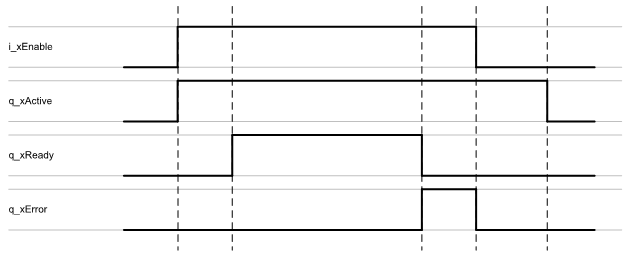Behavioral Model
General Information
The behavioral model describes the common behavior of all function blocks provided by this library.
By setting the input i_xEnable to TRUE, the function block starts the enabling process. The function block continues initialization and the output q_xActive is set to TRUE. Once the initialization is finished, the output q_xReady is set to TRUE.
If an error occurs, the output q_xError indicates TRUE and remains TRUE until the function block is disabled.
Common Input
|
Input |
Data type |
Description |
|---|---|---|
|
i_xEnable |
BOOL |
A rising edge FALSE -> TRUE activates and initializes the function block, a falling edge TRUE -> FALSE deactivates the function block. A deactivated function block does not execute actions and the outputs are set to the default value. |
Common Outputs
|
Output |
Data type |
Description |
|---|---|---|
|
q_xActive |
BOOL |
Indicates TRUE if the execution of the function block is active. As long as the output is TRUE, the function block must be executed cyclically. |
|
q_xReady |
BOOL |
Indicates TRUE if the function block is ready and can be controlled through its inputs according to its functionality. After the function block has been enabled with a rising edge of i_xEnable, the output q_xReady is only set to TRUE if the function block can process instructions from the inputs. If invalid input values are detected during initialization, q_xReady remains FALSE. If the function block has detected an error, q_xReady is set to FALSE. If the function block is deactivated using i_xEnable, q_xReady immediately becomes FALSE. |
|
q_xError |
BOOL |
Indicates TRUE if an error has been detected. For details, refer to q_etResult and q_sResultMsg. |
|
q_etResult |
Provides diagnostic and status information as a numeric value. |
|
|
q_sResultMsg |
STRING [255] |
Provides additional diagnostic and status information as a text message. |
